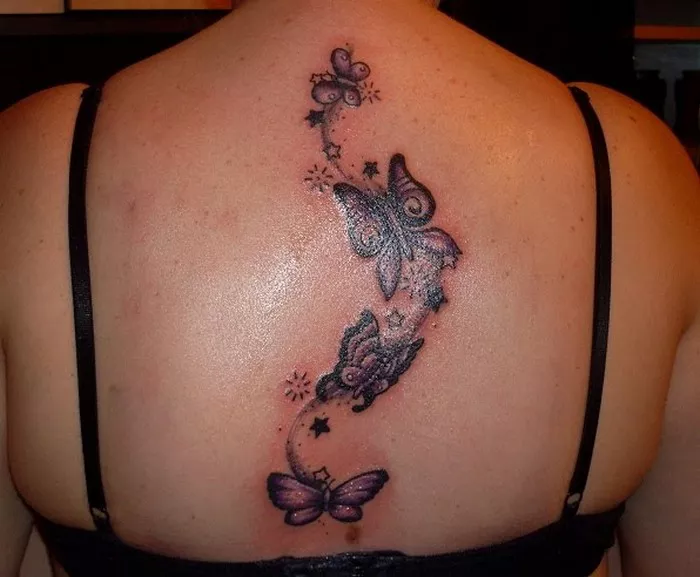Tattoos have long served as a form of self-expression, allowing individuals to adorn their bodies with meaningful symbols and designs. Among the myriad of tattoo choices, the butterfly stands out as a popular motif, celebrated for its beauty and rich symbolism. As individuals contemplate their next ink, one crucial consideration arises: where to place their butterfly tattoo. This article delves into the various placement options for butterfly tattoos, considering symbolism, design ideas, visibility, concealment, and size considerations.
Meaning and Symbolism of Butterfly Tattoos
Butterfly tattoos hold profound significance, often representing transformation, freedom, and beauty. The metamorphosis of a caterpillar into a butterfly serves as a potent metaphor for personal growth and evolution. As the butterfly emerges from its cocoon, it symbolizes the individual’s journey of self-discovery and transformation. Furthermore, butterflies are creatures of flight, evoking a sense of freedom and liberation. Their delicate wings and vibrant colors epitomize beauty and grace, making them a timeless symbol of aesthetic appeal.
Design Ideas of Butterfly Tattoos
Butterfly tattoos offer endless design possibilities, ranging from simple silhouettes to intricate, colorful patterns. Some opt for minimalist designs, featuring clean lines and subtle shading to capture the essence of the butterfly. Others embrace vibrant hues and intricate detailing, incorporating elements like flowers, vines, or geometric shapes to enhance the design’s complexity. Additionally, butterfly tattoos can be stylized to reflect various cultural or artistic influences, from traditional tribal motifs to modern watercolor techniques. The versatility of butterfly tattoo designs ensures that individuals can find a style that resonates with their personal taste and aesthetic preferences.
Placement Options for Butterfly Tattoos
The placement of a butterfly tattoo plays a crucial role in its overall impact and significance. Popular placement areas include the wrist, shoulder, neck, lower back, and ankle, each offering distinct advantages in terms of visibility and personal significance.
1. Wrist: Positioned on the inner or outer wrist, butterfly tattoos are easily visible and can serve as a constant reminder of personal transformation and freedom. This placement is ideal for those seeking a subtle yet meaningful tattoo that can be easily showcased or concealed with clothing or accessories.
2. Shoulder: Butterfly tattoos on the shoulder provide ample space for intricate designs and allow for easy concealment if desired. The shoulder area offers a canvas for larger, more elaborate tattoos that can extend onto the back or chest, making it a popular choice for those seeking a bold statement piece.
3. Neck: Neck tattoos are inherently visible and can make a bold statement of self-expression. Butterfly tattoos on the neck symbolize the individual’s desire to spread their wings and embrace their true nature openly. However, this placement may not be suitable for everyone, as it can be difficult to conceal in professional or formal settings.
4. Lower Back: Often referred to as the “tramp stamp,” butterfly tattoos on the lower back have garnered mixed reactions over the years. Despite the stigma associated with this placement, it remains popular among those seeking a sensual and feminine tattoo that can be easily concealed with clothing.
5. Ankle: Ankle tattoos are discreet yet meaningful, offering a subtle way to adorn the body with a butterfly motif. This placement is particularly popular among women, as it allows for elegant designs that accentuate the natural curves of the ankle while symbolizing freedom and independence.
Visibility and Concealment
When choosing the placement of a butterfly tattoo, individuals must consider their desired level of visibility and the potential need for concealment. Visible placements like the wrist, shoulder, and neck allow for easy showcasing of the tattoo, serving as a constant reminder of its symbolism and significance. However, these placements may not be suitable for all occasions, especially in professional or formal settings where tattoos may be frowned upon.
Conversely, placements like the lower back or ankle offer the option of concealment when necessary, allowing individuals to control who sees their tattoo and when. This versatility is particularly appealing for those who wish to maintain a professional image or adhere to societal norms while still expressing themselves through body art.
Size Considerations
The size of a butterfly tattoo can significantly influence the choice of placement. Smaller tattoos are well-suited to areas like the wrist, ankle, or neck, where space may be limited. These delicate designs are perfect for those seeking a subtle yet meaningful tattoo that can be easily concealed if needed.
Conversely, larger butterfly tattoos lend themselves to placements like the shoulder or lower back, where ample space allows for intricate detailing and elaborate designs. These bold statement pieces serve as focal points of self-expression, showcasing the individual’s artistic vision and personal journey.
In conclusion, the placement of a butterfly tattoo is a deeply personal decision that should reflect the individual’s style, symbolism, and practical considerations. Whether adorning the wrist, shoulder, neck, lower back, or ankle, each placement offers unique advantages in terms of visibility, concealment, and symbolic significance. By carefully considering these factors and exploring various design ideas, individuals can ensure that their butterfly tattoo becomes a timeless expression of their inner beauty and strength.

